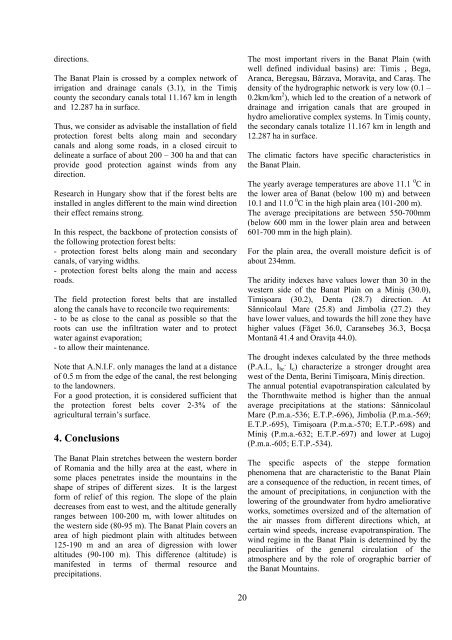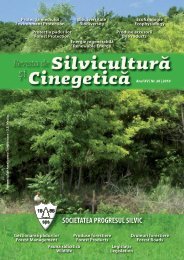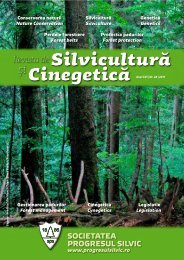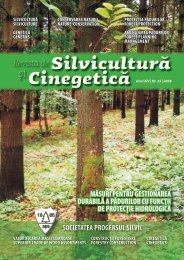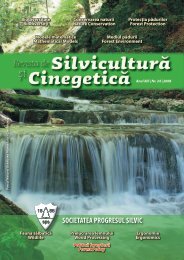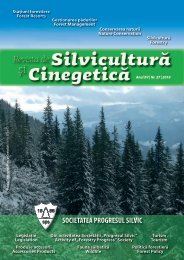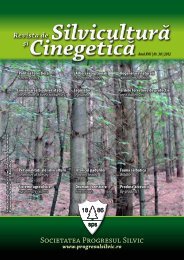Silviculture and Cinegetics Review - Societatea Progresul Silvic
Silviculture and Cinegetics Review - Societatea Progresul Silvic
Silviculture and Cinegetics Review - Societatea Progresul Silvic
Create successful ePaper yourself
Turn your PDF publications into a flip-book with our unique Google optimized e-Paper software.
directions.<br />
The Banat Plain is crossed by a complex network of<br />
irrigation <strong>and</strong> drainage canals (3.1), in the Timiş<br />
county the secondary canals total 11.167 km in length<br />
<strong>and</strong> 12.287 ha in surface.<br />
Thus, we consider as advisable the installation of field<br />
protection forest belts along main <strong>and</strong> secondary<br />
canals <strong>and</strong> along some roads, in a closed circuit to<br />
delineate a surface of about 200 – 300 ha <strong>and</strong> that can<br />
provide good protection against winds from any<br />
direction.<br />
Research in Hungary show that if the forest belts are<br />
installed in angles different to the main wind direction<br />
their effect remains strong.<br />
In this respect, the backbone of protection consists of<br />
the following protection forest belts:<br />
- protection forest belts along main <strong>and</strong> secondary<br />
canals, of varying widths.<br />
- protection forest belts along the main <strong>and</strong> access<br />
roads.<br />
The field protection forest belts that are installed<br />
along the canals have to reconcile two requirements:<br />
- to be as close to the canal as possible so that the<br />
roots can use the infiltration water <strong>and</strong> to protect<br />
water against evaporation;<br />
- to allow their maintenance.<br />
Note that A.N.I.F. only manages the l<strong>and</strong> at a distance<br />
of 0.5 m from the edge of the canal, the rest belonging<br />
to the l<strong>and</strong>owners.<br />
For a good protection, it is considered sufficient that<br />
the protection forest belts cover 2-3% of the<br />
agricultural terrain’s surface.<br />
4. Conclusions<br />
The Banat Plain stretches between the western border<br />
of Romania <strong>and</strong> the hilly area at the east, where in<br />
some places penetrates inside the mountains in the<br />
shape of stripes of different sizes. It is the largest<br />
form of relief of this region. The slope of the plain<br />
decreases from east to west, <strong>and</strong> the altitude generally<br />
ranges between 100-200 m, with lower altitudes on<br />
the western side (80-95 m). The Banat Plain covers an<br />
area of high piedmont plain with altitudes between<br />
125-190 m <strong>and</strong> an area of digression with lower<br />
altitudes (90-100 m). This difference (altitude) is<br />
manifested in terms of thermal resource <strong>and</strong><br />
precipitations.<br />
The most important rivers in the Banat Plain (with<br />
well defined individual basins) are: Timis , Bega,<br />
Aranca, Beregsau, Bârzava, Moraviţa, <strong>and</strong> Caraş. The<br />
density of the hydrographic network is very low (0.1 –<br />
0.2km/km 2 ), which led to the creation of a network of<br />
drainage <strong>and</strong> irrigation canals that are grouped in<br />
hydro ameliorative complex systems. In Timiş county,<br />
the secondary canals totalize 11.167 km in length <strong>and</strong><br />
12.287 ha in surface.<br />
The climatic factors have specific characteristics in<br />
the Banat Plain.<br />
The yearly average temperatures are above 11.1 0 C in<br />
the lower area of Banat (below 100 m) <strong>and</strong> between<br />
10.1 <strong>and</strong> 11.0 0 C in the high plain area (101-200 m).<br />
The average precipitations are between 550-700mm<br />
(below 600 mm in the lower plain area <strong>and</strong> between<br />
601-700 mm in the high plain).<br />
For the plain area, the overall moisture deficit is of<br />
about 234mm.<br />
The aridity indexes have values lower than 30 in the<br />
western side of the Banat Plain on a Miniş (30.0),<br />
Timişoara (30.2), Denta (28.7) direction. At<br />
Sânnicolaul Mare (25.8) <strong>and</strong> Jimbolia (27.2) they<br />
have lower values, <strong>and</strong> towards the hill zone they have<br />
higher values (Făget 36.0, Caransebeş 36.3, Bocşa<br />
Montană 41.4 <strong>and</strong> Oraviţa 44.0).<br />
The drought indexes calculated by the three methods<br />
(P.A.I., I hc<br />
,<br />
I c ) characterize a stronger drought area<br />
west of the Denta, Berini Timişoara, Miniş direction.<br />
The annual potential evapotranspiration calculated by<br />
the Thornthwaite method is higher than the annual<br />
average precipitations at the stations: Sânnicolaul<br />
Mare (P.m.a.-536; E.T.P.-696), Jimbolia (P.m.a.-569;<br />
E.T.P.-695), Timişoara (P.m.a.-570; E.T.P.-698) <strong>and</strong><br />
Miniş (P.m.a.-632; E.T.P.-697) <strong>and</strong> lower at Lugoj<br />
(P.m.a.-605; E.T.P.-534).<br />
The specific aspects of the steppe formation<br />
phenomena that are characteristic to the Banat Plain<br />
are a consequence of the reduction, in recent times, of<br />
the amount of precipitations, in conjunction with the<br />
lowering of the groundwater from hydro ameliorative<br />
works, sometimes oversized <strong>and</strong> of the alternation of<br />
the air masses from different directions which, at<br />
certain wind speeds, increase evapotranspiration. The<br />
wind regime in the Banat Plain is determined by the<br />
peculiarities of the general circulation of the<br />
atmosphere <strong>and</strong> by the role of orographic barrier of<br />
the Banat Mountains.<br />
20


